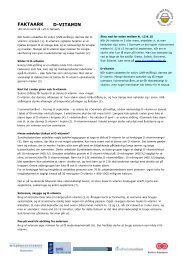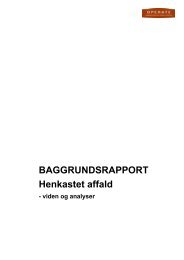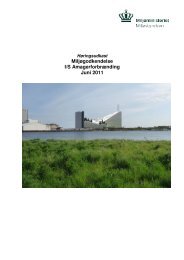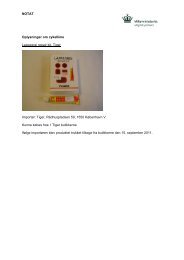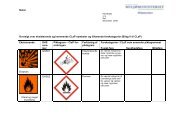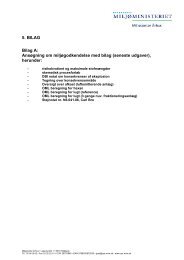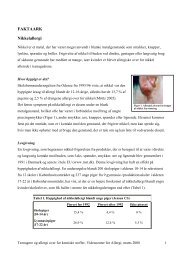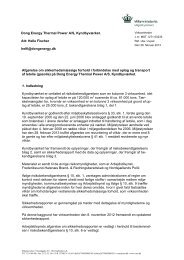Kilder til BAM-forurening - Miljøstyrelsen
Kilder til BAM-forurening - Miljøstyrelsen
Kilder til BAM-forurening - Miljøstyrelsen
You also want an ePaper? Increase the reach of your titles
YUMPU automatically turns print PDFs into web optimized ePapers that Google loves.
from vadose zone (in concentrations of up to 37 µg/l) as well in groundwater<br />
aquifers near the ground surface, which shows that <strong>BAM</strong> is s<strong>til</strong>l leaching<br />
through vadose zone to the groundwater. Often, 2.6-dichlorobenzoic acid also<br />
is detected in pore water samples from the vadose zone, indicating that <strong>BAM</strong><br />
is degraded since 2.6-dichlorobenzoic acid in the literature is reported as being<br />
a metabolite from <strong>BAM</strong>.<br />
Calculations show that the residuals of dichlobenil in soils from the upper few<br />
meters of the investigated sites can s<strong>til</strong>l cause groundwater contamination for<br />
many years to come. However, the main part of <strong>BAM</strong> is considered to have<br />
already infiltrated into deeper parts of vadose zone or into the groundwater<br />
aquifer.<br />
Apart from the direct infiltration of <strong>BAM</strong> from the contaminant sources there<br />
might be a risk of spreading <strong>BAM</strong> via surface water (streams) and rainwater<br />
runoff from roads and paved surfaces. For instance, rainwater basins without<br />
firm bottom imply a risk of infiltration into the groundwater of <strong>BAM</strong> polluted<br />
rainwater.<br />
Investigations of selected groundwater catchments have shown that the many<br />
<strong>BAM</strong> contaminant sources in urban and agricultural areas have caused widely<br />
spreaded <strong>BAM</strong>-pollution in the groundwater aquifers. The spreading of<br />
<strong>BAM</strong>-pollution is caused by leaching of <strong>BAM</strong> from all the contaminant<br />
sources resulting in many small pollution plumes which often seem to combine<br />
to larger coherent plumes due to the high mobility of <strong>BAM</strong>. The complex<br />
distribution of contaminant sources in the catchment areas combined<br />
with the spreading of <strong>BAM</strong> via surface water and runoff rainwater pattern<br />
makes it very difficult to identify preferential pathways from the contaminant<br />
source to the groundwater.<br />
In the Danish groundwater aquifers <strong>BAM</strong> pollution is found in concentrations<br />
above the official limit value for drinking water in on average 10% of the analysed<br />
wells (data from the official Groundwater Monitoring Programme,<br />
2000). However, the degree of <strong>BAM</strong> contamination varies from county to<br />
county from 1% in Frederiksborg County to 15% in Southern Jutland County.<br />
The difference in the frequence of <strong>BAM</strong> contamination may be due to different<br />
application doses of the herbicides, different land use, and different hydrogeological<br />
conditions. Most of the <strong>BAM</strong> findings originate from groundwater<br />
at a depth of up to 40 meter, but <strong>BAM</strong> has also been observed in<br />
groundwater reservoirs at a depth of 100 meter.<br />
Transport via leaky wells<br />
Groundwater <strong>BAM</strong> contamination caused by transport of pollution through<br />
leaky wells requires that the dichlobenil containing herbicides have been applicated<br />
close to the well.<br />
Investigations in this project combined with experiences from other studies<br />
show that there is a potential risk of leaks through well constructions as a result<br />
of drilling techniques, well construction techniques and well construction<br />
materials. Evidence of defective well construction was recorded in 84 % of<br />
172 wells investigated. In all wells constructed before 1980 there may be a risk<br />
of leaks due to one or more constructional errors. Many relatively newly established<br />
wells, however, are defective too.<br />
19








